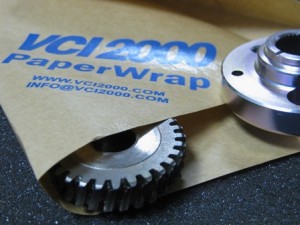In the vast landscape of industrial operations, were metals reign supreme, the specter of corrosion looms as a constant threat. Corrosion, with its stealthy advances and pervasive nature, can undermine the structural integrity and longevity of metals. However, in this battle against the forces of decay, a formidable ally emerges in the form of VCI technology. This post delves into the intricacies of VCI, unveiling its power in safeguarding metals from corrosion, and explores the six key aspects that make it a revolutionary force in the realm of industrial preservation.
The Genesis of VCI: A Revolutionary Approach to Corrosion Prevention
Before we dive into the nuanced details of VCI’s power, let’s unravel its genesis. VCI technology represents a departure from traditional methods of corrosion prevention. Unlike coatings or inhibitors that require direct contact with the metal surface, VCIs employ a vapor-phase approach. This innovative strategy involves the release of volatile corrosion inhibitors in the surrounding environment, creating a protective atmosphere around the metal.
1. The Invisible Shield: How VCI Creates a Molecular Fortress Against Corrosion
At the heart of VCI’s power lies its ability to construct an invisible shield around metal surfaces. This shield is not physical, yet it proves to be a formidable defense against corrosion. The volatile corrosion inhibitors vaporize into the air, forming a molecular fortress that settles on the metal, creating a barrier against corrosive elements.
This invisible shield is a game-changer, especially in industries where the aesthetic appeal of metal surfaces is crucial. Unlike traditional coatings that may alter the appearance of metals, VCI allows the natural luster and finish to remain intact while providing robust protection against corrosion.
2. Elemental Resilience: Adapting to Varied Environmental Conditions
Metals face a multitude of environmental challenges, from extreme temperatures to varying humidity levels. VCI technology showcases its power by adapting to these diverse conditions. Whether metals are stored in a dry, arid climate or face the moisture-laden atmosphere of coastal regions, VCIs adjust their protective measures accordingly.
This elemental resilience makes VCI an ideal choice for industries with operations in diverse geographic locations. The adaptability of VCI ensures that metals receive consistent and effective protection, regardless of the environmental challenges they encounter.
3. Time-Tested Protection: Long-Term Corrosion Prevention
In the battle against corrosion, the concept of longevity is crucial. VCI technology stands out by providing time-tested protection. Once deployed, VCIs continue to release inhibitors over an extended period, ensuring that metals remain shielded from corrosion even in long-term storage or during prolonged transportation.
This aspect is particularly significant for industries that deal with large quantities of metal components or finished products. The assurance of long-term protection translates to reduced maintenance costs, increased operational efficiency, and a longer lifespan for valuable metal assets.
4. Tailored Defense: VCI’s Customizable Approach to Different Metals
Metals come in various compositions and alloys, each with its unique susceptibility to corrosion. VCI technology boasts a customizable approach, offering tailored defense mechanisms for different types of metals. Whether it’s steel, aluminum, or other alloys, VCIs can be formulated to address the specific corrosion challenges associated with each metal.
This tailored defense is a strategic advantage, allowing industries to implement a nuanced corrosion prevention strategy that aligns with their diverse range of metal assets. The ability to customize VCI formulations enhances the overall effectiveness of corrosion protection across various applications.
5. Mobile Safeguard: Protecting Metals in Transit
The journey from production facilities to end-users or distribution centers can be perilous for metals. Exposure to fluctuating environmental conditions, humidity, and the rigors of transportation pose significant challenges. VCI technology, however, acts as a mobile safeguard.
VCI-treated packaging materials, such as films and papers, create a protective cocoon around metals during transit. This ensures that regardless of the mode of transportation—be it by land, sea, or air—metals arrive at their destination in optimal condition, free from the corrosive effects of the journey.
6. Eco-Friendly Fortification: Sustainable Corrosion Prevention
In an era where sustainability is at the forefront of industrial practices, VCI technology emerges as an eco-friendly fortification against corrosion. Traditional corrosion prevention methods often involve the use of toxic coatings and chemicals that can be harmful to the environment.
VCI’s eco-friendly nature lies in its ability to eliminate the need for these hazardous substances. By creating a vapor-phase protective barrier, VCIs contribute to a more sustainable and environmentally conscious approach to corrosion prevention. This aligns with the growing global emphasis on adopting green practices across industries.
Implementing the Power of VCI: Best Practices for Industries
Understanding the power of VCI is just the first step. To harness its full potential, industries must adopt best practices in the implementation of VCI technology:
a. Strategic Deployment:
Identify critical points in the metal production and supply chain where VCI technology can be strategically deployed. This includes storage facilities, transportation routes, and even during the manufacturing process.
b. Regular Monitoring:
Implement a system for regular monitoring of VCI-treated metals. Periodic checks ensure that the protective atmosphere is consistently maintained, and any anomalies can be addressed promptly.
c. Collaboration with VCI Suppliers:
Forge strong collaborations with VCI suppliers. Stay informed about the latest advancements in VCI formulations and applications. Regular communication with suppliers ensures that industries remain at the forefront of VCI technology.
d. Employee Training:
Provide training to personnel involved in the application and monitoring of VCI technology. Understanding the nuances of VCI deployment enhances the effectiveness of corrosion prevention strategies.
The Future of VCI: Innovations on the Horizon
As we look to the future, the trajectory of VCI technology promises even more innovative solutions in the fight against corrosion. Researchers are exploring advancements such as smart VCI technology that incorporates sensors for real-time monitoring and nanotechnology integration for enhanced protective qualities.
The evolution of VCI continues to push the boundaries of what is possible in the realm of corrosion prevention. These advancements not only bolster the power of VCI but also open doors to new applications and industries that can benefit from this groundbreaking technology.
Conclusion: Empowering Industries with VCI’s Protective Spell
In the grand tapestry of industrial operations, where metals play a central role, VCI technology stands as a powerful ally. Its ability to create an invisible shield, adapt to varied environmental conditions, provide long-term protection, offer customizable defense, act as a mobile safeguard, and contribute to sustainable practices positions VCI as a transformative force in the battle against corrosion.
As industries unveil the power of VCI, they empower themselves to preserve the integrity and longevity of their metal assets. Beyond the immediate benefits of corrosion prevention, the adoption of VCI aligns with the broader goals of sustainability, operational efficiency, and a commitment to responsible industrial practices.
In the ongoing narrative of industrial operations, VCI emerges as a protagonist, weaving a protective spell that safeguards metals from the corrosive forces that seek to diminish their strength and resilience. As industries embrace this revolutionary technology, they not only fortify their metals but also contribute to a future where the battle against corrosion is won through innovation, sustainability, and the transformative power of VCI.






